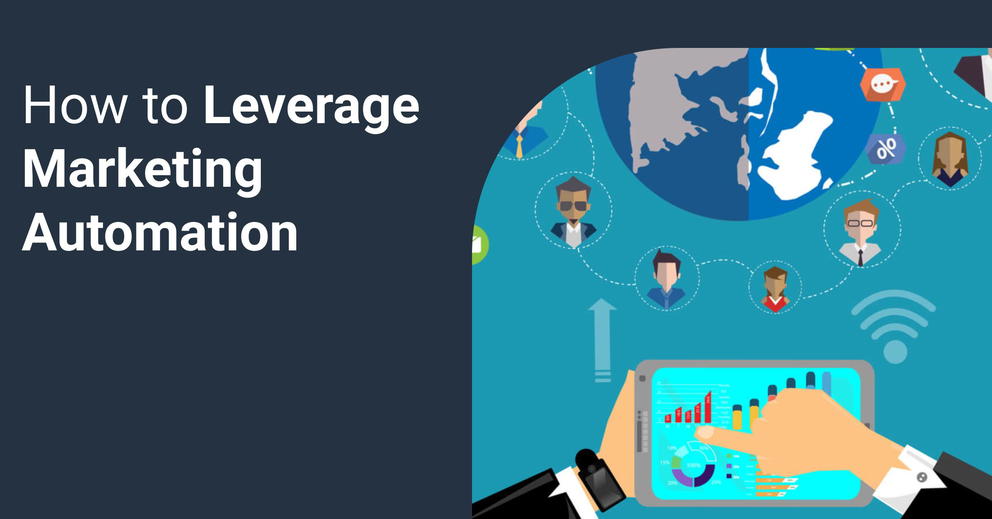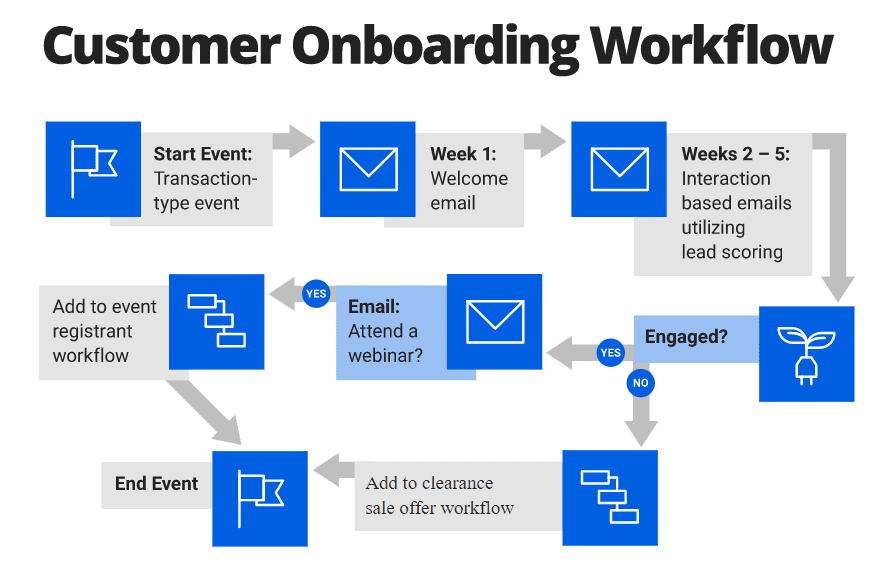Create a Successful Automation Strategy for Your Business in 7 Steps
Automation is becoming more common-place in a variety of industries.- marketing is reaping big rewards in this regard. A streamlined approach to your marketing automation can bolster ROMI significantly!

May 03 2021 ● 9 min read

- What Is Marketing Automation?
- Benefits Of Automation
- Step #1: Choose What You Want To Automate
- Step #2. Determine Automation Processes
- Step #3. Identify And Involve Key Stakeholders
- Step #4: Pick The Right Tools For Your Automation Goals
- Step #5: Plan And Rollout Your Automation Project Correctly
- Step #6: Track And Improve Your Automation Strategy
- Step #7: Find The Right Balance Between Automation And The Human Touch
- Business Automation: More Than A Buzzword
Unless you live under a rock, you know marketing automation is trending these days.
Today’s marketing mix has many ever-moving pieces.
It takes a smart automation strategy to combine all pieces of the puzzle. In this article, you will discover 7 steps to help you create a successful automation strategy.
What Is Marketing Automation?
Marketing automation is using technology platforms to manage marketing tasks or processes across many channels automatically.
Whether it’s retargeting visitors on social media or crafting error-free sales proposals, automation does it all.
Benefits Of Automation
There are many advantages automation brings to your business. Below are the top 7 benefits you should embrace automation for your business.
- Releases you and your team to focus on more complex tasks.
- Increases efficiency since you don’t have to do everything manually.
- Helps you personalize your marketing campaigns.
- Boost customer engagement levels.
- Clear the way for smoother and faster movement of leads through your sales pipeline.
- Saves time you can use for other things.
- Ultimately, automation increases revenue.
In particular, marketing automation is a great fit for personal brands. In the beginning, building a personal brand is tough because you do it as a one-person team. You wear so many hats to keep things moving. Even mature personal brands have small teams, so automation lightens the heavy load.
Now that you understand marketing automation and its benefits, let’s get into the heart of the matter.
Let’s explore the 7 steps to creating a successful automation strategy for your business.
Step #1: Choose What You Want To Automate
The first and most critical step you must take when creating a successful automation strategy for your business is answering the what question.
Rushing your automation strategy isn’t helpful. You will make blunders. How? By automating parts of your business that won’t affect your ROI. Make sure you determine what you want to automate carefully.
To begin with, which aspect of your marketing tasks do you want to focus on?
- Lead generation
Do you want to attract and qualify the right leads?
- Lead segmentation
Do you want to put the leads you’ve gained into the right buckets for relevant marketing messages?
- Lead nurturing
Is your goal doing your best to develop deeper relationships with your leads so they trust you more?
- Customer support
Or maybe you want to ensure your customers have the best experience with your product or service?
- Social media management
Do you want to improve the efficiency of your social media engagement efforts?
It all depends on which growth stage your business is at.
Are you a new business?
Then it makes sense to focus your automation efforts on top of the funnel activities like lead generation and list building.
But if you are a mature business that wants to boost sales and customer retention prioritize something else. You may be better off if you automate email lead nurturing and pre/post-sale activities.
Step #2. Determine Automation Processes
Now that you know what you want to automate, you are ready for the next step.
Describing exactly what you want your automation software to do. How does the perfect workflow look like for what you want to achieve?
Consider these 3 workflow software automation steps as you design your process.
- Draw up your workflow
Map out your automation workflow from A to Z. To make your job easier, you can create a workflow diagram first. Use if and then scenarios to detail your campaign, step by step. Let’s say you are a freelancer and want to build an email workflow for new subscribers. Here’s what you could jot down.
- A prospect downloads your lead magnet resource, e.g. report or roadmap.
- They receive a welcome email that explains what they can expect in the coming days.
- They get a case study that shows your expertise next.
- They receive another case study that focuses on a different context.
- They get a bunch of short video testimonials from delighted customers.
- They get a pitch email promoting your services.
Also, determine the time duration between events.
See this email automation sample.

Source: Smartsheet
- Collect the needed resources
Each of your automation steps needs a resource for customers to consume.
Once they engage the resource, they are ready to move to the next stage.
These resources include:
- Blog posts.
- Case studies.
- Webinars.
- Podcast episodes.
- Reports.
- Frequently Asked Questions (FAQ) page.
- Landing page.
Line up all the marketing resources you need to educate or entice your customers to take the next step in your buyer’s journey.
- Decide the automation triggers
Next, what needs to happen to set off or continue your automation workflow? They call this a trigger event.
Here are some trigger event examples:
- Submitting a form on your website.
- Clicking on a specific link.
- Opening a certain email.
- Viewing your services/products page.
- Downloading a resource.
- Buying a product.
- Reaching out to the support team.
- Personal milestones like birthdays.
- Product anniversaries.
- Brand interaction frequency on social media.
Get the idea?
Not only should you set triggers to launch your workflow. But you must also establish actions or inactions that you will use to let people exit your workflow if they aren’t interested.
But determining your automation process isn’t all. You’ve got to consider another vital element in your automation mix—the people.
Step #3. Identify And Involve Key Stakeholders
You know what?
Your automation processes are only as good as the people who manage them. So, for your automation strategy to click, pinpoint key stakeholders.
- C-level management
Without buy-in from top management, your automation project becomes a stillbirth. Imagine getting the best software in your industry only for management to shoot down the idea at the last minute. Better court their favor from the get-go.
- Workers
Pull in your IT staff and developers. Tell them what you have in mind. Listen to their suggestions. Also, bring in the people who will manage the software. Ask them the day-to-day challenges they want the upcoming platform Get their input on the challenges they want the upcoming automation tools to fix.
- Vendors
Last, rope in the software vendors of the platforms you’re targeting. Squeeze as much info as you can about their product. Learn about common use cases. Get demos and training material. Having these resources will help you sell the benefits of your automation campaign to the management and team.
Once you’ve got important people behind you, move on to the next step.
Step #4: Pick The Right Tools For Your Automation Goals
Now comes the fourth step.
Have you picked what you want to automate? Check.
Have you determined your automation process? Check.
Have you identified your key stakeholders? Check.
Then it’s time to pick the right marketing automation software. If you’ve done your homework, this task is simple because you know exactly what you want to achieve.
Automation white label software covers the entire customer journey.
They include:
- Lead generation tools.
- Lead automation tools.
- Email automation programs.
- Customer Relationship Management Tools (CRM).
- Ad automation tools.
- Cross-channel marketing automation tools.
- Customer experience automation tools.
- Data synchronization tools
- Customer engagement automation software.
- Social media automation platforms.
- Sales funnel automation platforms.
Spoiled for choice, huh?
Whichever sales or marketing job you want to do, there’s the perfect tool for it. It’s all about which software ticks all the boxes for your automation strategy.
Step #5: Plan And Rollout Your Automation Project Correctly
Thereafter, with your sleek automation tools on hand, it’s planning time.
Releasing your tools without proper planning will disrupt your processes. Or frustrate your teams, even.
Here’s how to plan your rollout strategy.
- Set goals where you spell out what you want to achieve.
- Setting up a training schedule so everyone gets up to speed with your strategy.
- Kickoff meeting when you launch your much-expected automation strategy.
- Review meetings to fix any teething problems that may arise.
- Reporting meetings for giving feedback to the top management.
Solid plans help you keep everything smooth.
Step #6: Track And Improve Your Automation Strategy
Once you’ve set up and launched your automation strategy, it’s time to go to bed, right?
Catch some z’s while your system works its magic.
Nope.
You can’t just set it and forget it.
Marketing automation doesn’t work that way. You should track and tweak your automation system for the best results. Tracking helps you:
- See what’s working or isn’t in your processes.
- Identify friction points that need ironing.
- Spot growth opportunities you can take advantage of.
You could monitor performance via the individual dashboards of the programs that make up your automation mix.
But you can go one step better.
Ideally, get a multi-channel data monitoring tool.
Here’s why that’s a smart move.
- Track KPIs across channels like email and social media.
- Monitor PPC ad automation expenses and results.
- Get a combined report of all vital numbers from one place.
- Deliver intelligent, easy-to-understand reports to your clients.
As you can see, a cross-channel data tool makes everything simpler.
Use your tracking results to improve your automation strategy.
Tweak. Deploy. Tweak.
Rinse and repeat until you get everything just right.
Step #7: Find The Right Balance Between Automation And The Human Touch
Phew.
Congratulations. You’ve now reached the last step.
While automation is superb, you can’t automate everything.
That’d be disastrous.
Some tasks lend themselves to automation. Others need the human touch. Your ability to find the sweet spot between the two will determine the success (or failure) of your automation strategy.
Determine what needs machines
First, decide the chores machines will do.
Choose automation for tasks are:
- Formulaic
Let your automation system take over any predictable customer experiences. Machines perform such tasks faster and more efficiently than people. Posting social media content to engage your audience is a perfect example of a chore automation software can do.
- Time-consuming
Automate humdrum parts of your customer journey. Any monotonous, laborious tasks steal your energy from important tasks. Leave those to the machines. Imagine segmenting leads manually. Or sending marketing SMSs to your clients one by one? You’d waste hours of your day.
- Precision Tasks
For tasks that require laser-accurate answers, automation software is your best bet.
People will make mistakes that can destroy your company’s reputation.
While automation is great, the human touch does a better job in certain instances.
Determine what needs the human touch
Customer interactions that require deep, intelligent conversations need humans.
Yes, chatbots can have sharp conversations with prospects and customers. But they are limited interactions that may not go deep enough. In the end, you won’t satisfy customers. So, direct human-to-human interaction is best in such situations.
Also, humans shine in marketing tasks that involve empathy and negotiation. Human beings are also matchless for creative tasks.
Your delicate task is to determine what makes sense to automate.
The goal?
To find the perfect mix between automation and the human touch.
Business Automation: More Than A Buzzword
In summary, business automation is here to stay.
It’s not a craze.
Instead, nailing your automation strategy is an integral part of being a successful modern business.
With these tips, I’m sure you will get it right and grow your business.
Published on May 03 2021

WRITTEN BY
Indrė Jankutė-CarmaciuIndrė is a copywriter at Whatagraph with extensive experience in search engine optimization and public relations. She holds a degree in International Relations, while her professional background includes different marketing and advertising niches. She manages to merge marketing strategy and public speaking while educating readers on how to automate their businesses.